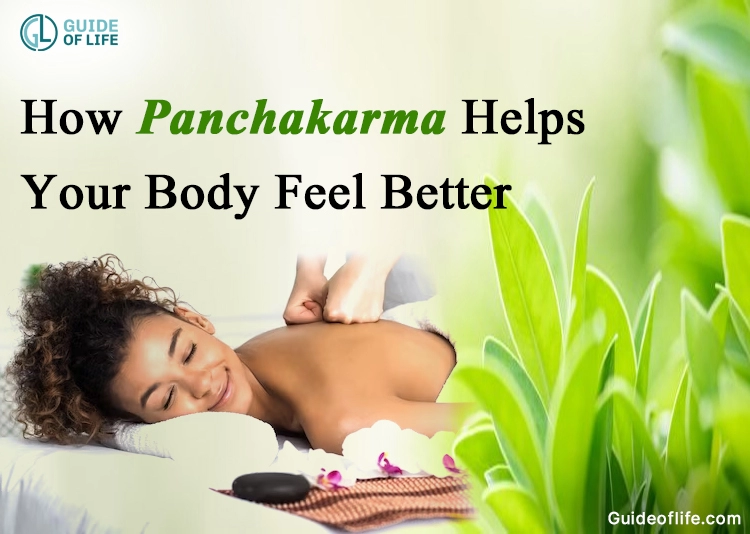How Panchakarma Helps Your Body Feel Better

Do you ever feel tired, slow, or sick for no reason? Do you ever wonder how to get rid of the bad things that build up in your body over time? If yes, then you might want to try Panchakarma, an old Ayurvedic way that can clean, make better, and rejuvenate your body and mind.
Read More: 11+ Dincharya Ayurvedic Habits for a Healthier Daily Life
What is Panchakarma in Ayurveda?
Panchakarma means "five actions" or "five treatments" in Sanskrit. It is a whole way that tries to take out the extra and unwanted waste things from your body, which are called ama in Ayurveda.
Ama in Ayurveda
Ama is a sticky, bad-smelling, and bad thing that can cause many diseases and problems in your body. Panchakarma helps to take out ama and make right the balance of your three doshas, which are Vata, Pitta, and Kapha, which are the important energies that control your physical, mental, and emotional health.
How does Panchakarma work?
Panchakarma has five main steps that are made for your own body, problem, and needs. These steps are:
- Vamana: This is a step of making yourself vomit that helps to take out the extra mucus and phlegm from your breathing and eating systems. It is very good for people with Kapha imbalance, who have asthma, bronchitis, sinusitis, or are very fat.
- Virechana: This is a step of making yourself poop that helps to take out the extra bile and bad things from your liver and gallbladder. It is very good for people with Pitta imbalance, who have acidity, ulcers, skin problems, or swelling.
- Basti: This is a step of putting medicine water in your butt that helps to clean and feed your large intestine and small intestine. It is very good for people with Vata imbalance, who have hard poop, arthritis, back pain, or nervous problems.
- Nasya: This is a step of putting medicine oil or powder in your nose that helps to clear and make your nose and head wet. It is very good for people with Vata or Kapha imbalance, who have allergies, headaches, or mental stress.
- Rakta Moksha: This is a step of letting blood out that helps to clean and make new blood and blood systems. It is very good for people with Pitta or Kapha imbalance, who have skin diseases, blood problems, or infections.
Read More: 22 Ayurvedic Beauty Tips for Daily Skin Care Routine
Before doing these steps, you need to make your body ready by following a pre-cleaning plan that includes:
- Snehana: This is a step of putting medicine oil or ghee on your body and eating them. It helps to make your tissues and channels wet and soft, and loose the ama from your cells.
- Svedana: This is a step of making yourself sweat by using steam, sauna, or hot cloth. It helps to make big holes and channels, and take out the ama from your body.
After doing these steps, you need to follow a post-cleaning plan that includes:
- Sansarjana Krama: This is a step of slowly eating solid food again after a time of not eating or only drinking. It helps to make your digestion fire and body work better, and stop any problems or bad effects.
- Rasayana: This is a step of making young herbs or things that help to feed and make strong tissues and organs, and make your body strong and full of life.
Read More: 20 Amazing Places for River Rafting Adventures in India
How long does Panchakarma therapy take?
The time needed for Panchakarma therapy is different for each person depending on their problem, needs, and how they feel after the treatment. Usually, it takes around 21 days to finish a full Panchakarma treatment. But, it can be changed according to your needs. Some things that can change how long you need to do the Panchakarma therapy are:
- How bad and what kind of disease or problem you have
- What kind and how many steps of Panchakarma treatment you need
- How much getting ready and cleaning you need before and after the therapy
- How fast you get better and stronger after the therapy
- How well you follow the rules and help with the therapy
It is good to talk to an experienced and qualified Ayurveda doctor before doing Panchakarma therapy. The doctor can check your body, problem, and needs, and tell you the right Panchakarma treatment for you. The doctor can also guide you on how to take care of yourself before, during, and after the treatment.
Read More: How Ayurveda Helps You Say Goodbye to Joint Pain
Another important part of Panchakarma therapy is the Panchakarma diet, which is a special kind of food that helps to clean and make your body better. The Panchakarma diet is based on the idea of making your three energies in your body right: Vata, Pitta, and Kapha. When your energies are not right, you can get sick and unhappy. The Panchakarma diet helps to take out the bad things and extra energies from your body and make you healthy and happy. The Panchakarma diet is mostly made of kitchari, which is a simple and good food made of rice and lentils cooked with spices and herbs. Kitchari is easy to eat and helps to take out the bad things from your body. You also need to drink a lot of water and herbal teas to make your body wet and clean. You need to avoid coffee, alcohol, and other drinks, as well as processed, fried, spicy, and sweet foods, as they can make your energies worse and stop the cleaning process. The Panchakarma diet is different for each person, depending on their problem, needs, and how they feel after the treatment.
Conclusion
Panchakarma, brought to you by Guide of Life, is an ancient Ayurvedic therapy for body and mind cleansing. With five personalized steps, it removes toxins and balances energies. The 21-day process involves a special diet, including kitchari. Consultation with an Ayurveda doctor is crucial. Overall, Panchakarma aims to make you feel better by cleaning and balancing your body, serving as a powerful guide to a healthier life.

